Oatmeal Bread with Cinnamon and Raisins is one of the breads on the list for the Mellow Bakers for August. I was really looking forward to making this bread. My youngest son is home from college for a couple of weeks and oatmeal bread happens to be one of his favorites. The timing was great!
Oatmeal with cinnamon and raisins is delicious and healthy in and of itself, but when you add the combination to bread, you’ve got yourself a pretty awesome treat. I thought this would make some exceptional cinnamon toast so I baked the loaf in a Pullman pan.
Instead of using high gluten flour and whole wheat flour as per the original formula, I used Super SproutTM flour and bread flour along with the rolled oats. Super SproutTM is a whole grain organic wheat that has been sprouted using a proprietary method and milled into flour for baking. The wheat flavor of this sprouted flour is deeper, smoother and more well-rounded than plain whole wheat flour.
As I mentioned in a previous post on Whole Wheat Bread, I learned about Super SproutTM at the Asheville Bread Baking Festival during Peter Reinhart’s workshop. This flour is milled by Lindley Mills. I’m not sure if it is readily available yet, but it is supposed to be in markets soon.
Cinnamon Raisin Bread with Oatmeal & Sprouted Wheat
Makes: 1 Pullman Loaf
Adapted from Bread: A Baker’s Book of Techniques and Recipes by Jeffrey Hamelman
Ingredients:
- 12 oz bread flour (plus more for sprinkling)
- 4 oz sprouted wheat flour
- 2.6 oz rolled oats
- 12 oz water
- 1.7 oz milk
- 1 1/2 tablespoon honey
- 2 1/2 tablespoons neutral flavored oil
- 1/2 tablespoon + 1/4 teaspoon salt
- 1/2 tablespoon instant yeast
- 1 tablespoon cinnamon
- 1 cup raisins
Directions:
- Soak the raisins in water for at least 30 minutes (or overnight) before mixing.
- Place the oats in the mixing bowl. Add the water and turn the machine on for a moment to moisten all the oats. Let stand for 15 to 20 minutes to soften. I soaked the oats and the flours in the water for about 20 minutes.
- Add all of the remaining ingredients except the raisins to the bowl. Mix on first speed for 3 minutes in order to incorporate the ingredients thoroughly. The dough will be moderately loose, with a slight tackiness from the honey. Mix an additional 3 to 3 1/2 minutes on second speed, until the gluten has been moderately developed. Add the drained raisins and mix on first speed just until the raisins are thoroughly incorporated throughout the dough.
- Let the dough ferment for 2 hours or overnight. I covered the dough and put it the refrigerator overnight.
Edited 3/27/2013: The original formula indicates that you can shape the dough after a 2-hour bulk ferment, however, some readers have had issues with the dough still being too wet. For this dough, I would recommend placing it in the refrigerator overnight to make sure the gluten is developed completely. Or, let it proof on the counter for 2-3 hours and perform a couple of folds and turns in the bowl (during the first hour) to help develop the gluten. You will still probably need to use a little extra flour for sprinkling when shaping the loaf to keep it from sticking.
- The next day, remove the dough from the refrigerator and let it warm up to room temperature. Preshape the dough lightly into a round.
- Cover the ball with plastic wrap and let it rest seam-side up on a counter sprinkled with flour until it has relaxed sufficiently. This should take about 15 to 20 minutes.
- Shape the dough into a blunt log and place it a greased Pullman pan. I think my log could’ve been a little blunter. It looked more like a batard.
- Slide the lid on the Pullman pan and let the dough rise for 1 1/2 to 2 hours or until it reaches the top of the pan. Preheat the oven to 450 degrees F. Spray the loaf with water and gently press rolled oats into the top of the loaf.
- Bake the loaf for 15 minutes, then lower the temperature by 20 to 30 degrees and continue baking for about 30 minutes. The raisins as well as the milk, honey, and oil contribute to the coloring of the loaf so lowering the temperature partway through the baking will keep it from burning.
- Remove the pan from the oven and immediately remove the loaf from the pan to keep the crust from getting soft from the moisture.
Let the bread cool completely before slicing and serving. This makes it easier to slice.
I let this loaf cool for several hours, then put it in a plastic bag until the next day. Then I sliced it and enjoyed it toasted. As I suspected, it makes delicious cinnamon toast. My son had 5 slices in one sitting. His metabolism still works so he can do that and go out and run it off.
This bread has been YeastSpotted. Please visit Wild Yeast to view all of the lovely breads in the roundup.

Mellow Bakers was started by Paul at Yumarama.
We’ve been baking breads from Bread: A Baker’s Book of Techniques and Recipes by Jeffrey Hamelman.
Thanks for visiting the Bread Experience bread-baking blog. I hope you’ll join me again soon.
Happy Baking!
Cathy
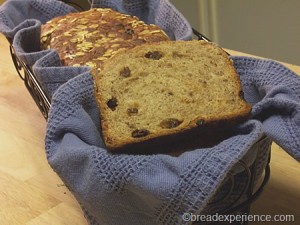
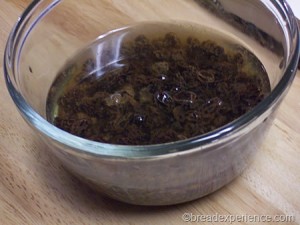
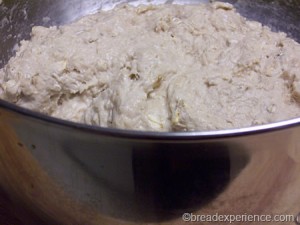
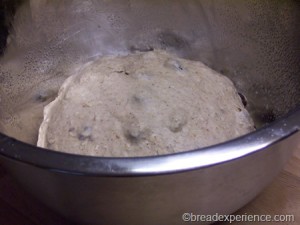
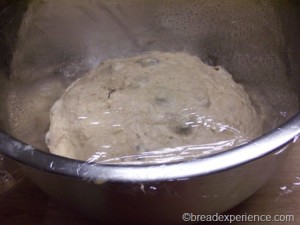
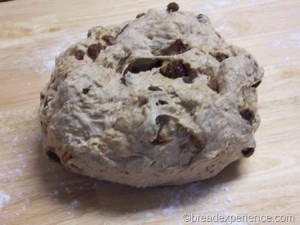
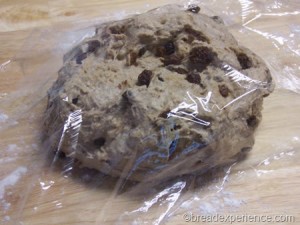
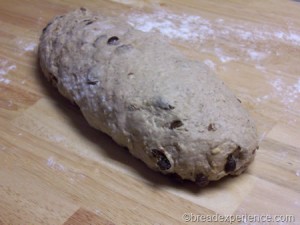
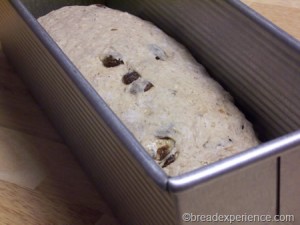
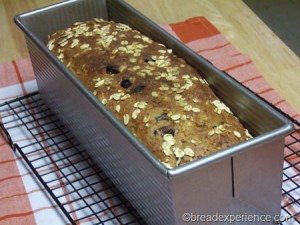
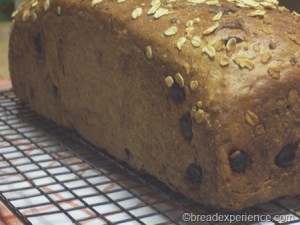
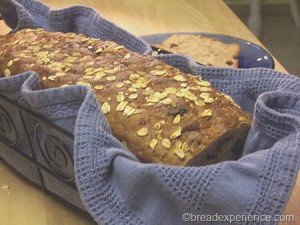
Winnie says
Wow, this bread looks wonderful!
I’d lovvvvvvve a slice with lots of butter 🙂
Actually make it 2 slices (or 3…..)
🙂
Anonymous says
Will this work if I use my own hard winter wheat that I have sprouted
Cathy Warner says
Hello, I haven’t tried this bread with sprouted grains, only the sprouted wheat flour. It would work (like this recipe) if you dried the sprouted grains first, then ground them into flour. Or, if you want to experiment, try the sprouted grains and see how you like it. Just chop them up in the blender or food processor before mixing the dough.
Anonymous says
I did dry the wheat and ground into flour but my dough appears to be very wet. Is the total amt of flour in the recripe 2 cups? I have it resting right now and plan on baking tonight. Should I wait the 2 hours before forming the loaf for the 2nd rise. I thought instant yeast only required one rise? Help?
Anonymous says
I did dry them and ground into flour first. I have it resting for the 2 hours but the dough appears to be very loose. Should I wait the entire 2 hours before shaping it into the loaf and doing the second rise. Thznk
a friend tried this receipe twice without success.
Anonymous says
I’ve been trying to post another question
my dough is very wet. Is the total amt of flour correct?
my dough is rising for the second time right now. I let it rest for almost 2 hours but the dough was still very wet . I didn’t refrigerated overnight and have it doing the 2nd rise now. Isn’t using instant yeast eliminate one rise?
Help?
Anonymous says
Is it possible that the amt of water in this receipe is 1.2 oz and not 12 oz?
Cathy Warner says
I’m sorry you and your friend had trouble with this recipe. I appreciate the feedback.
The amounts for the flour and water are correct. I think the issue is the overnight rest in the refrigerator. Although Hammelman’s original formula states that you can do either a 2-hour rest or let it rest in the refrigerator overnight, I think the overnight rest is the key because it allows the gluten more time to develop. When I took the dough out of the refrigerator, it was not wet. It was easy to work with. I will edit the instructions accordingly. You can certainly adjust the water as you see fit, but my recommendation would be to either allow the slack dough to rest in the refrigerator overnight, or give it more proofing time on the counter and do a couple of folds and turns (in the bowl every hour) to make sure the gluten is developed properly.
The difference between instant and active dry yeast is that you don’t have to activate instant yeast (in warm water) before using it in a recipe. You still need to do the bulk proof and the final proofing, depending on the recipe.
I hope this helps. I’m sorry I didn’t see you feedback earlier.
Cathy
Rya says
How would this recipe be adjusted for a bread machine?
Cathy W. says
Hi Rya,
You can probably mix the dough in the bread machine, but I wouldn’t recommend baking the loaf in it. This dough benefits from a couple of folds and turns in the bowl during the bulk fermentation to develop the gluten or even an overnight rest in the refrigerator. You also need to soak the raisins and the oats before incorporating them into the dough.